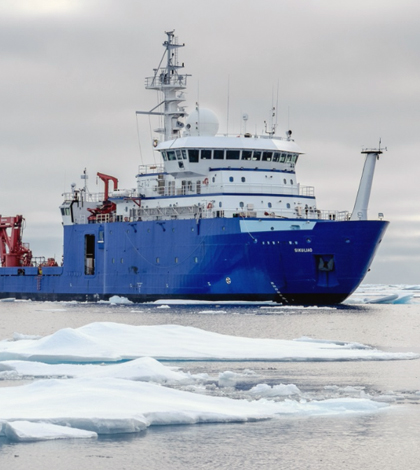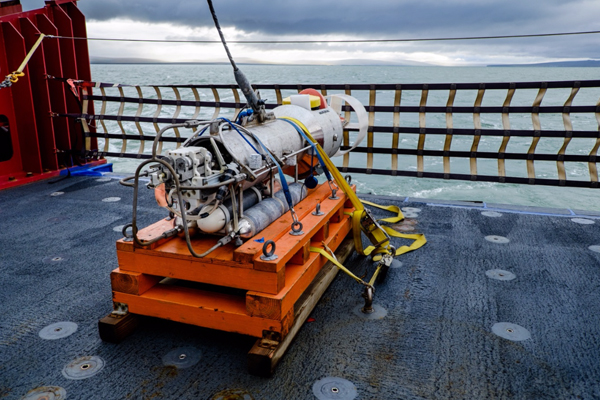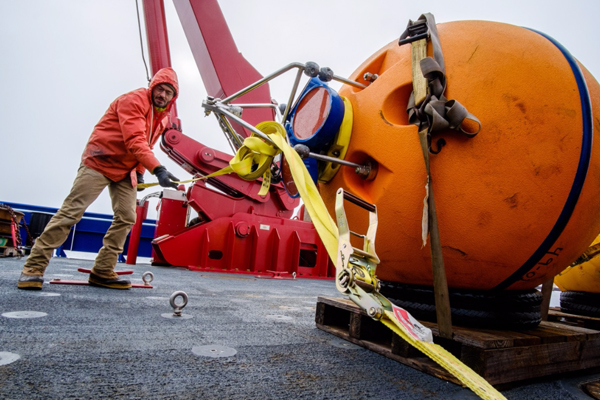At The Top Of The World, Scientists Get To The Bottom Of Arctic Ocean Mixing

R/V Sikuliaq amidst Beaufort Sea ice during the fourth lowest Arctic sea-ice minimum. (Credit: Thomas Moore)
The Arctic Ocean still has chunks of ice, but more ice melts every year, and the late-summer minimum of ice this year is one of the lowest on record. It may seem like the sun beating down on the ice would be the primary cause of melt, but as John Mickett, senior oceanographer at the Applied Physics Lab of the University of Washington has observed, an even larger source of warmth for melting the ice can come from below.
The heat coming up from under the ice is due to the phenomenon of turbulent mixing. Mickett and a dedicated group of U. Washington researchers and others from the Scripps Institution of Oceanography recently returned from a voyage devoted to understanding the link between powerful ocean turbulence which brings heat to the surface of the Arctic Ocean and the relationship of ocean mixing to ice melt and global warming.
Mickett collaborates with several people in the ongoing development of the unique instrumentation used on the ArcticMix voyage aboard the R/V Sikuliaq, chief among them Mike Gregg, also of U. Washington’s Applied Physics Lab. Gregg is one of the foremost experts in the field of ocean mixing.
One of the pieces of instrumentation central to their work is the Shallow Water Integrated Mapping System.
As Mickett explains, “Our SWIMS is basically designed to give extremely high-resolution pictures of the ocean. It’s lowered into the ocean using a winch on deck, and the instrument package is towed at 3 to 5 knots, rapidly profiling between the surface and up to 500-meter depth.” They commonly describe it as “a rock on a string,” but of course much more complex. The SWIMS instrument package can measure temperature, conductivity, ocean density, oxygen content, salinity, chlorophyll concentration (using a fluorimeter) and turbulent distribution of heat (using an instrument Gregg and engineers came up with called a Chiometer). SWIMS was developed with the help of Seabird Scientific.

The Shallow Water Integrated Mapping System (SWIMS) on the deck of the R/V Sikuliaq in Port Clarence, Alaska. (Credit: Thomas Moore)
Movement of water and heat in the ocean can occur laterally or it can travel up and down the water column. Mickett is especially interested in the powerful turbulent mixing that occurs vertically in the water column, bringing heat from the warmer deeper waters of the Arctic Ocean to the colder surface.
“The Arctic Ocean is upside down from a normal ocean, which typically has warmer water on top and colder water in the depths. In the Arctic at times, we see intense turbulent movement of this warmer, deeper water up to the cold surface,” Mickett explains.
Another instrument employed on SWIMS is an Acoustic Doppler Current Profiler, which allows scientists to measure ocean current velocities using Doppler effects of sound waves on water column particles. Velocity of ocean currents can be measured up to 100 meters above or 100 meters below the SWIMS instrument package.
On the cruise they also used the Modular Microstructure Profiler, which is a free-falling profiler that measures both standard oceanographic variables such as temperature, oxygen, salinity and pressure as well as the properties of ocean turbulence. With this instrument they can calculate the rate at which heat is moved by turbulence vertically in the water column. They use shear probes, which are like little phonograph needles that create small voltages, which in turn can measure rapid and small-scale turbulent motions.
Using these instruments, Mickett and the other researchers were able to measure intense ocean mixing that was largely unexpected.
“The mixed layer can be quite shallow, maybe the top ten meters of the water column,” says Mickett, “which was surprising given the strength of the winds at times. This is one of the reasons for the large values for the turbulent movement of heat.”
He also uses a string of temperature, pressure and salinity sensors over the side of the ship. There are 20 to 30 sensors, each of which takes data every second. “Even a kilometer of ocean can have lots of variability. The scales in the ocean can be surprisingly small in the Arctic because of a number of factors,” says Mickett.

John Mickett deals with an Acoustic Doppler Current Profiler mounted on a syntactic foam mooring float. (Credit: Thomas Moore)
In addition to all the other instrumentation, Mickett and his colleagues use a McLane Moored Profiler, a robot coupled to a wire 3.7 kilometers below the ship. It has Acoustic Doppler Profilers from Seabird Instruments and can measure temperature, salinity, pressure, density and turbidity.
Though still doing preliminary data interpretation from the current voyage, Mickett reveals that future research plans are underway to build a SWIMS to get more refined turbulence measurements and faster velocity measurements. Mickett also hopes to add very small acoustic accelerometers for measurement of ocean velocity.
Mickett has been surprised at the strength of ocean mixing he has been finding in the ArcticMix voyage data. They observed that the warm water coming from the Bering Strait has been a full 6 degrees Celsius warmer than the background water, which he never expected. He’s also been delighted at how well SWIMS has worked and the extremely high quality of the microstructure information they have managed to obtain.
“We likely have resolved a warm Beaufort eddy in higher detail than anyone has ever accomplished up here,” Mickett enthuses. “We hope that these measurements will fill in several puzzle pieces of dominant processes in the region.”
Mickett has also learned that the heat fluxes coming from just below the mixed layer of the Arctic Ocean are larger than anyone would have thought. “They’re larger than the ones coming from the sun at times. The sun has been heating at 400 watts per meter squared, but the heat from the ocean is 700 watts per meter squared. In other words, at times, the heat from below is more responsible for melting Arctic ice than the heat from the sun above.”
Mickett emphasizes that the Arctic Ocean seems to be constantly trying to restratify, and there are forces causing it to relax from a lateral gradient to a vertical gradient. “Current global climate change models are missing this process,” he points out.
Top image: R/V Sikuliaq amidst Beaufort Sea ice during the fourth lowest Arctic sea-ice minimum. (Credit: Thomas Moore)




0 comments